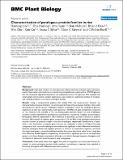Characterization of paralogous protein families in rice
Author(s)
Lin, Haining; Ouyang, Shu; Egan, Amy; Nobuta, Kan; Zhu, Wei; Gu, Xun; Silva, Joana C; Meyers, Blake C; Buell, C. Robin; Haas, Brian J.; ... Show more Show less
Download1471-2229-8-18.pdf (448.7Kb)
PUBLISHER_CC
Publisher with Creative Commons License
Creative Commons Attribution
Terms of use
Metadata
Show full item recordAbstract
Background: High gene numbers in plant genomes reflect polyploidy and major gene duplication events. Oryza sativa, cultivated rice, is a diploid monocotyledonous species with a ~390 Mb genome that has undergone segmental duplication of a substantial portion of its genome. This, coupled with other genetic events such as tandem duplications, has resulted in a substantial number of its genes, and resulting proteins, occurring in paralogous families. Results: Using a computational pipeline that utilizes Pfam and novel protein domains, we characterized paralogous families in rice and compared these with paralogous families in the model dicotyledonous diploid species, Arabidopsis thaliana. Arabidopsis, which has undergone genome duplication as well, has a substantially smaller genome (~120 Mb) and gene complement compared to rice. Overall, 53% and 68% of the non-transposable element-related rice and Arabidopsis proteins could be classified into paralogous protein families, respectively. Singleton and paralogous family genes differed substantially in their likelihood of encoding a protein of known or putative function; 26% and 66% of singleton genes compared to 73% and 96% of the paralogous family genes encode a known or putative protein in rice and Arabidopsis, respectively. Furthermore, a major skew in the distribution of specific gene function was observed; a total of 17 Gene Ontology categories in both rice and Arabidopsis were statistically significant in their differential distribution between paralogous family and singleton proteins. In contrast to mammalian organisms, we found that duplicated genes in rice and Arabidopsis tend to have more alternative splice forms. Using data from Massively Parallel Signature Sequencing, we show that a significant portion of the duplicated genes in rice show divergent expression although a correlation between sequence divergence and correlation of expression could be seen in very young genes. Conclusion: Collectively, these data suggest that while co-regulation and conserved function are present in some paralogous protein family members, evolutionary pressures have resulted in functional divergence with differential expression patterns.
Date issued
2008-02Department
Broad Institute of MIT and HarvardJournal
BMC Plant Biology
Publisher
BioMed Central Ltd
Citation
BMC Plant Biology. 2008 Feb 19;8(1):18
Version: Final published version
ISSN
1471-2229